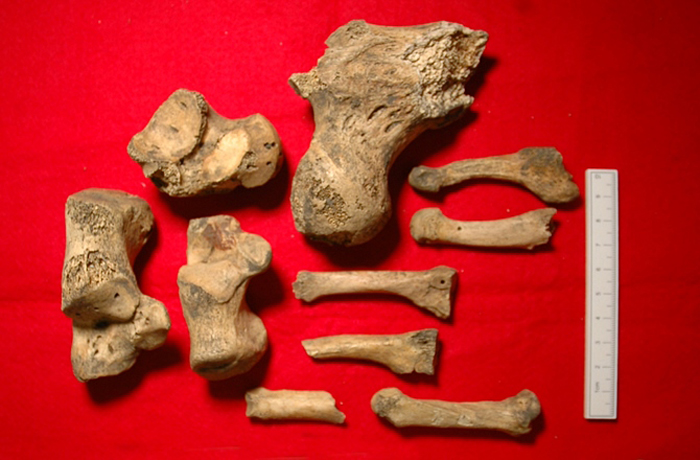Severed Heads Eaten by Dogs in Roman Times

Forensic techniques have shed light on the gruesome fate of dozens of people whose severed heads were thrown into open pits 2,000 years ago and left there to decompose.
Excavated in the heart of London more than 25 years ago and dated to between 120 and 160 A.D., the skulls are believed to have belonged to defeated gladiators or victims of Roman soldiers’ practice of “headhunting,” in which heads of enemies were displayed as trophies.
PHOTOS: Jamestown Settlers Turned to Cannibalism
“At least one of the skulls shows evidence of being chewed at by dogs, so it was still fleshed when it was lying in the open,” said Rebecca Redfern, from the Center for Human Bioarchaeology at the Museum of London.
The skulls and bones appear to have belonged to about 40 young men. They were excavated in 1988 from a Walbrook stream site within the Roman city walls and deposited at the nearby Museum of London.
It wasn’t an unusual finding. Skulls and human remains have been recovered from the Walbrook Valley for over 175 years. They were often interpreted as bones washed out of Roman cemeteries, or victims of the Boudican rebellion — decapitated and thrown into the river when the Iceni tribe, who led a revolt against the Roman Empire in 60-61 A.D., torched Roman settlements and towns.
But improved forensic techniques revealed that the skulls had a different fate.
Get the world’s most fascinating discoveries delivered straight to your inbox.
NEWS: Deformed, Pointy Skull from Dark Ages Unearthed
According to Redfern and colleague Heather Bonney, from the Earth Sciences Department of the Natural History Museum, the remains were deposited over a 40-year period in 11 pits or dumps.
“Therefore, it was not just one event,” Redfern said.
The majority of the skulls had numerous blows to the head, which were probably the cause of death.
“Many also had healed injuries, suggesting that violence was a common feature of their life,” Redfern and Bonney wrote in the Journal of Archaeological Science.
“As there is no evidence for warfare or civil unrest in London at the time, the two most likely scenarios to explain this evidence is that they represent deaths in the arena –- executed criminals or defeated gladiators — or trophy heads displayed at the fort,” Redfern told Discovery News.
NEWS: Skulls in China Reveal Mass Female Sacrifice
The remains belonged to men mostly between the ages of 25 and 35 and consisted of a number of bones and 39 skulls. They feature direct, blunt force blows to the face, mouth and sides of the head, possibly the result of arena combats.
“These are the first human bones that could be the remains of gladiators from Britain,” Redfern said.
Other skulls, one in particular, show evidence of decapitation marks. Decapitation was a way of finishing off gladiators, but also criminals executed in Londinium’s amphitheater, which at the time was close to the Walbrook pits.
The evidence for decapitation, the large number of skulls and the unusual injuries observed on a male individual all would support the hypothesis that some of these remains derive from trophy heads.
“Nor does the evidence exclude the possibility that the fleshed/decomposing material was displayed, without mounting or suspension, at the fort or forum, with their eventual disposal in the nearby ritual space of the Walbrook Valley,” the researchers wrote.
Headhunting was practiced by the Roman army, most likely by their auxiliary troops, and is depicted on tombstones from the north of England and also on Trajan’s column, whose carvings portray Roman soldier holding up the heads of “barbarian” enemies defeated in battle.
The skulls offer rare evidence of Roman headhunting in Britain (there are cases from Roman forts and settlements such as Colchester and Vindolanda). They also represent an unexpected behavior, since they were disposed of in pits right in the heart of the city.
“By law, people were not allowed to be buried within the walls of the settlements so it is very unusual. It’s the first evidence from Roman London for this activity,” Redfern said.
This story was provided by Discovery News.


